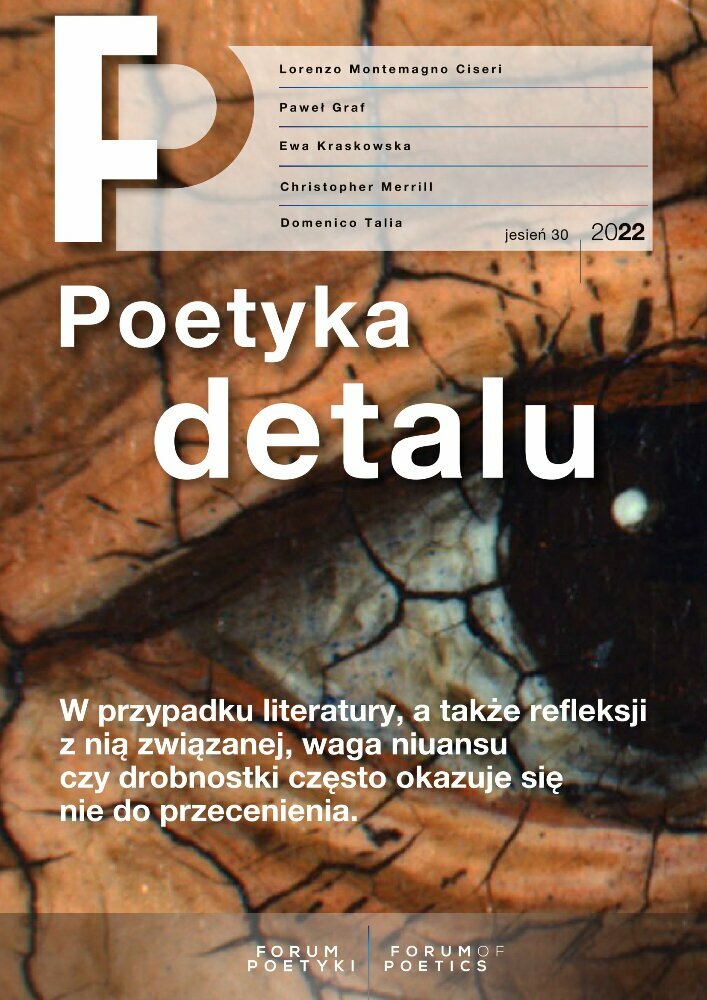Abstract
This article is devoted to the analysis of Marcin Ostrychacz’s poems collected in the volume Cielenie lodowca [Iceberg calving]. The article examines the poems using the concepts of the environmental catastrophe and the almost unimaginable scale on which it is taking place. Both concepts play a crucial role in the eco-critical discourse. The author tries to prove that by using the category of the detail, Ostrychacz strives to regain conceptual control over both notions. The poet sees the Earth as a detail in the cosmos and thus is able to process the phenomena which function on a wider planetary plane and find a counterbalance to the apocalyptic visions.
References
Budnik, Agnieszka. „Od zagłady ludzkości do pytania o szczęście”. Wielkopolska. Kultura u podstaw, 14.08.2020. https://kulturaupodstaw.pl/od-zaglady-ludzkosci-do-pytania-oszczescie/.
Buell, Frederick. From Apocalypse to Way of Life. Environmental Crisis in the American Century. Nowy Jork: Routledge, 2003.
Buell, Lawrence. The Environmental Imagination. Thoreau, Nature Writing, and the Formation of American Culture. Cambridge: Belknap Press of Harvard University, 1995. DOI: https://doi.org/10.2307/j.ctv1nzfgsv
„Edgar Mitchell’s Strange Voyage”, People, 8.04.1974. https://people. com/archive/edgar-mitchells-strange-voyage-vol-1-no-6/.
Fiedorczuk, Julia. Cyborg w ogrodzie. Wprowadzenie do ekokrytyki. Gdańsk: Wydawnictwo Naukowe Katedra, 2015.
Fiedorczuk, Julia. Inne możliwości. O poezji, ekologii i polityce. Rozmowy z amerykańskimi poetami. Gdańsk: Wydawnictwo Naukowe Katedra, 2015.
Fiedorczuk, Julia. „Przeciw apokalipsie”, Przekrój, 11.08.2021. https://przekroj.pl/artykuly/felietony/przeciw-apokalipsie-julia-fiedorczuk.
Ganguly, Debjani. „Catastrophic Form and Planetary Realism”. New Literary History 2 (2020): 419–453. DOI: https://doi.org/10.1353/nlh.2020.0025
Keller, Lynn. Recomposing ecopoetics. North American Poetry of the Self-Conscious Anthropocene. Charlottesville: University of Virginia Press, 2017. DOI: https://doi.org/10.2307/j.ctv6sj6qg
LeGuin, K. Ursula. Nie ma czasu. Myśli o tym, co ważne. Tłum. Piotr W. Cholewa. Warszawa: Prószyński i S-ka, 2019.
Marzec, Andrzej. „«Jesteśmy połączonym z sobą światem»Timothy Morton i widmo innej wspólnoty”. Teksty Drugie 2 (2018): 88–101. DOI: https://doi.org/10.18318/td.2018.2.6
Ostrychacz, Marcin. Cielenie lodowca. Poznań: WBPiCAK, 2020.
Piechura, Joanna. „Zaangażować wyobraźnię”, Dwutygodnik, grudzień 2021. https://www.dwutygodnik.com/artykul/9874-zaangazowac-wyobraznie.html.
Popkiewicz Marcin. „6 Raport IPCC. Podsumowanie dla decydentów po polsku”. Nauka o klimacie, 10.11.2021. https://naukaoklimacie.pl/aktualnosci/6-raport-ipccpodsumowanie-dla-decydentow-po-polsku/.
Singer, Peter. Wyzwolenie zwierząt. Tłum. Anna Alichniewicz, Anna Szczęsna. Warszawa: Marginesy, 2018.
Szaj, Patryk. „Czas, który wypadł z ram. Antropocen i ekokrytyczna lektura tekstów literackich”. Forum Poetyki 24 (2021): 6–25. DOI: https://doi.org/10.14746/fp.2021.24.30229
Ubertowska, Aleksandra. „Krajobraz po katastrofie: natura, historia, reprezentacja”. W: Poetyki ekocydu. Historia, natura, konflikt, red. Aleksandra Ubertowska, Dobrosława Korczyńska-Partyka, Ewa Kuliś, 7–22. Warszawa: Instytut Badań Literackich PAN, 2019.
Widhe, Olle. „Modes of environmental imagination. The eco-movement and the representation of reality in Swedish children literature from 1967 to 1977”, Barnelitterært forskningstidsskrift 1 (2019): 1–16 DOI: https://doi.org/10.18261/issn.2000-7493-2019-01-04
License
Copyright (c) 2022 Dawid Borucki

This work is licensed under a Creative Commons Attribution-NonCommercial-NoDerivatives 4.0 International License.
Authors of articles are responsible for securing the rights to other publications (texts, tables, drawings and other illustrations) quoted or reproduced in their texts.

